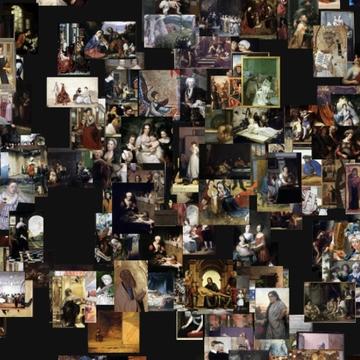New Directions in Digital Visual Studies: (en)coding Heritage Seminar Series

image credit: PixPlot, Yale University
This event is part of the TORCH en(coding) Heritage Network.
Register using the following link:
https://durhamuniversity.zoom.us/webinar/register/WN_To6vV0NBR3Wq_T4Ejbslwg
The (en)coding Heritage Seminar Series brings together researchers who are working at the cutting edge of digital technologies, humanities and heritage science. The second session in the series is devoted to New Directions in Digital Visual Studies.
Programme:
Allison Leigh, University of Louisiana at Lafayette
Using Digital Art History to Reassess the Catalogue Raisonné: The Case of Edouard Manet
Although it has long been speculated that the French painter Edouard Manet suffered from and perhaps even died of complications relating to syphilis, the exact effect his condition had on his painting practice has never been clearly established. This talk uses the catalogue raisonné of Manet’s work in tandem with digital humanities tools for classifying data to reconstruct the nature of the artist’s increasing debility in terms of the works he produced in his final decade. Using digital humanities tools to assess the entire volume of Manet’s works allows one to trace patterns and connections which were formerly hidden from view. By conducting an analysis which takes into account the ways that Manet physically adapted his artistic practice to his increasing debility and pain, this essay creates a fuller picture of the art and life of one of history’s greatest modern painters and opens up new methodological possibilities within the field.
Nicola Carboni, University of Geneva
An Ontology for the Description of Visual Heritage
The analysis of our visual heritage has traditionally focused on features, characters and ideas present in a single or a small set of visual work(s), revealing an artist’s aesthetic and cultural influences. To create a wider perspective over the employment of specific visual devices and symbolic representations, we propose the use of an extension of CIDOC-CRM, called VIR (Visual Representation). VIR extends CIDOC-CRM introducing new relationships to annotate the diverse visual elements present in a representation, giving the possibility to track across time and space the presence of a character, the use of a distinctive attribute, as well as the change in reference of a representation or one of its parts. The results were tested with artworks from the Church of Asinou, a small Byzantine foundation in Cyprus. The contribution will present the ontology, demonstrate its use, as well as make evident the advantages and disadvantages of an ontological descriptive approach (data usage) versus a computer vision approach (data generation).
Tess Colwell, Catherine DeRose and Lindsay King; Yale University
Images as Data: Visualizing Visual Resource Collections
Our presentation will demonstrate how Yale’s open-source PixPlot [http://github.com/YaleDHLab/pix-plot] software provides a platform for engaging and interpreting Visual Resource Collections (VRC) in new ways and at new scales. The software uses a convolutional neural network to ‘featurize’ tens of thousands of images into a high-dimensional space and then applies an advanced dimensionality reduction algorithm to display those images in a web browser such that visually similar images cluster near one another. For example, images of human sculptures will cluster near one another while painted portraits will form their own cluster. These algorithmically generated clusters provide quick, high-level insights into large visual collections. Using Yale’s VRC—which consists of more than 370,000 digital items comprised of lantern slides, 35mm slides, and photographs—as a case study, we will demonstrate how PixPlot works from both a creator and end user point-of-view, walking through the steps from dataset ingestion to curation, selection, and export.
Jorge Sebastián Lozano, Universitat de València
So Close, Yet So Distant. Geography and Digital Art History
Traditionally, geographical approaches have been scarce, but never entirely absent from academic art history discourse. The relationships between centers and peripheries (or the mere validity of that approach), the role of empires, diasporas, the travels of artists and artworks, trade routes and networks, patterns of influence and hybridization, natural, cultural or political borders… the possible spatial approaches to the study of art history are indeed diverse and meaningful. Giving attention to objects’ overall cycles of production, trade, dissemination, usage, collecting and display is already guiding analysts towards global scale visualizations. Such approach has been championed in literary studies by Franco Moretti, through his distinction between close and distant reading. In a similar vein, while not proposing to leave behind the keen study of canonical artworks and characters, this presentation attempts to provide some reflections on the requirements and consequences that a distant viewing approach brings to art history, specifically thanks to a well-informed usage of GIS, thus helping to bridge the long-established divide between the two disciplines.
Organised by the (en)coding Heritage Network in collaboration with Leonardo Impett, Durham University. For questions, please email encodingheritage@gmail.com.
Register using the following link:
https://durhamuniversity.zoom.us/webinar/register/WN_To6vV0NBR3Wq_T4Ejbslwg
(en)coding Heritage Network, TORCH Networks


